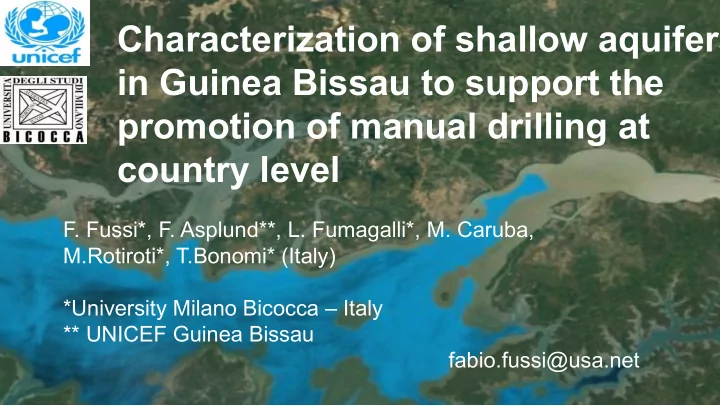

Characterization of shallow aquifers in Guinea Bissau to support the promotion of manual drilling at country level F. Fussi*, F. Asplund**, L. Fumagalli*, M. Caruba, M.Rotiroti*, T.Bonomi* (Italy) *University Milano Bicocca – Italy ** UNICEF Guinea Bissau fabio.fussi@usa.net
GUINEA BISSAU Extension: 36,125 km2 I Morphology: flat or slightly ondulated Climate: warm all year. Average yearly temperature: 26.3 °C Intense precipitation concentrated from June to September. Yearly rainfall in Bissau: 2024 mm Geology of Guinea Bissau is characterized by a division in two main sectors: West part of the country (Mesozoic Basin) including Quaternary-Tertiary groups East part including Paleozoic and Crystalline formations Fussi et al. - 44th IAH 2017 – Groundwater Heritage and Sustainability
WHY PROMOTING MANUAL DRILLING IN GUINEA BISSAU? In Guinea Bissau still 35% of rural population has no access to safe water (2012). Most of them are living in small villages UNICEF and DRGH (Direção Geral de Recursos Hídricos) wants to assess the potential of manual drilling as a low cost solution to provide safe water to these areas In 2016 a preliminary study to assess the suitability for manual drilling in the country and identify those regions with favourable conditions has been carried out. This study is the continuation of the mapping of suitable zones for manual drilling already completed by UNICEF in 16 African Countries (www.unicef.org/wash/index_54332.html, plus Zambia, Burundi, Guinea Conakry and Guinea Bissau) Fussi et al. - 44th IAH 2017 – Groundwater Heritage and Sustainability
SUITABILITY FOR MANUAL DRILLING Suitability for manual drilling is a combination of 2 factors POTENTIAL FOR FEASIBILITY EXPLOITATION possibility to drill a hole using manual drilling Semi-quantitative assessment techniques of potential yield and size of the user’s group It takes into consideration other two aspects: Presence and thickness of hard laterite Water quality Fussi et al. - 44th IAH 2017 – Groundwater Heritage and Sustainability
METHOD OF ELABORATION MAP OF GEOLOGICAL GROUPS (FROM MAP OF GEO- GEOLOGICAL MAP) ENVIRONMENTAL MAP OF ENVIRONMENTAL UNITS GROUPS (BASED ON DTM) SPATIALISATION OF FEASIBILITY AND POTENTIAL SCORES HYDROGEOLOGICAL INPUT AND PARAMETERS AND CODIFICATION OF ASSESSMENT OF MAP OF SUITABILITY STRATIGRAPHIC LOGS FEASIBITY AND POTENTIAL AT LOGS MAP OF COMBINED POSITIONS APTITUDE Fussi et al. - 44th IAH 2017 – Groundwater Heritage and Sustainability
GEO-ENVIRONMENTAL GROUPS GEOLOGICAL GROUPS Sedimentary Cristallyne ENVIRONMENTAL GROUPS Coastal areas Plateau (slightly ondulated) Fussi et al. - 44th IAH 2017 – Groundwater Heritage and Sustainability
EXTRACTION OF HYDROGEOLOGICAL PARAMETERS FROM STRATIGRAPHIC LOGS DATA SOURCE Stratigraphic logs obtained from national water authority (DGRH), UNICEF and local drillers DATA PROCESSING The method is adapted from the previous experience in Senegal and Guinea (Fussi, 2014. 37 th WEDC Conference, Hanoi) Manual input of data in a specifically designed spreadsheet Assigning standard terms to describe each geological layer Extraction of percentage of different texture classes at 1m regular steps Extraction of hydrogeological parameters for each log (up to 30 m deep) Fussi et al. - 44th IAH 2017 – Groundwater Heritage and Sustainability
HYDROGEOLOGICAL PARAMETERS AT LOGS POSITION Fussi et al. - 44th IAH 2017 – Groundwater Heritage and Sustainability
FROM HYDROGEOLOGICAL PARAMETERS TO THE ASSESSMENT OF FEASIBILITY AND POTENTIAL DEPTH TO WATER FEASIBILITY AT DEPTH TO HARD ROCK LOGS POSITION THICKNESS OF HARD LATERITE POTENTIAL AT THICKNESS OF COARSE LAYERS LOGS POSITION (HIGHLY PERMEABLE) DISTRIBUTION OF FEASIBILITY AND POTENTIAL BY GEO ENVIRONMENTAL UNITS Fussi et al. - 44th IAH 2017 – Groundwater Heritage and Sustainability
SPATIALISATION Weighted average of class of feasibility, potential and presence of laterite at borehole logs, aggregated by geo-environmental group Fussi et al. - 44th IAH 2017 – Groundwater Heritage and Sustainability
SUITABILITY FOR MANUAL DRILLING Fussi et al. - 44th IAH 2017 – Groundwater Heritage and Sustainability
ESTIMATION OF COMBINED APTITUDE % OF TERRITORY BY CLASS OF APTITUDE Fussi et al. - 44th IAH 2017 – Groundwater Heritage and Sustainability
RESULTS AND CONCLUSION In Guinea Bissau 53% of the territory has good or excellent aptitude for manual drilling 366.000 inhabitants are using unsafe water sources. 90% of them live in areas with suitable condition for manual drilling Manual drilling is a valid low cost option to cope with some of the major problems concerning access to safe water in Guinea Bissau
RESULTS AND CONCLUSION At the end of the research, the information of 500 borehole logs is available, organized in a well structured geographic database and suitable for automatic extraction of hydrogeological parameters for shallow and deep aquifers. This dataset shows the potential relevance of converting to numeric database of more than 5000 stratigraphic logs stored in hard copy in national institutions in Guinea Bissau. Data processing and map production has been done with free and open source software. This makes easier to promote further data analysis and mapping for a large group of users.
Thanks for your attention Fabio.fussi@usa.net
Recommend
More recommend